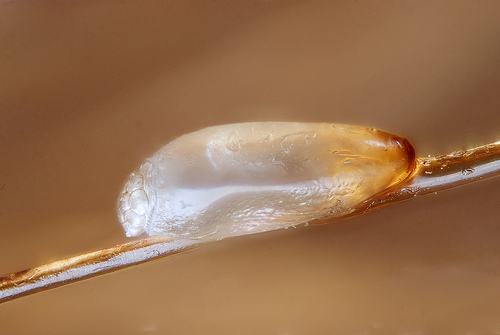Above: This lice nit (or egg) is obviously magnified enormously. Actual nits are much harder to see. But apparently an outbreak in lower grades means you should be on the lookout. (Image posted to Flickr by Giles San Martin)
A concerned mother asked me to raise awarness about lice in our lower schools.
It seems that there has been an unusually high number of cases this fall. In fact, the notes from Finn School’s health office last Thursday shared:
Unfortunately I am hearing about and seeing more cases of head lice this year than in recent years. A classic symptom of head lice is scratching the head, particularly around the ears and nape of the neck. A nit (egg) is an oval, tear drop shaped particle about the size of a comma (,) that is firmly adhered to the hair shaft. Your school nurse is an excellent resource for information about head lice, please feel free to call. If your child is treated for head lice, they must be checked by the nurse prior to returning to school.
So, keep a vigilent watch on your kids’ heads and scratching hands.
And even if you’ve already talked to your kids about not sharing hats – they probably won’t connect that to wigs and masks. With costume parties coming up this week, you may want to have another chat.
I know this time of year some friends braid their daughters’ hair and/or religiously spray it. (Supposedly, lice don’t like the way the repellent spray smells. Unfortunately, neither do some of the girls it’s used on!)
I don’t have any personal experience with lice (knocking on wood as I type this), so I don’t have anything else useful to share. But feel free to post questions here for others or share your own tips.



What is meant by an ‘unusually high number of cases’? Such claims are frequently made, but invariably there’s no substance on which to base those claims. Misdiagnosis is surprisingly rampant, and this helps perpetuate much of the folklore surrounding the biology, risk and management of head lice. The image used as part of this story is of a louse egg, but it a dead egg. The embryo within never developed, and no louse will ever hatch from it. Before jumping to the conclusion that a child is infested, a living (crawling) head louse should be discovered. Dead and hatched eggs do not provide sufficient evidence of an active infestation.
In just my son’s class alone, up to 56% of the students have head lice. I believe the root of the problem is undetected cases and kids returning to school too soon after it is detected. All but one of our family member’s heads were checked and one was reported to have lice, when in fact all but one of us had it–later detected that same day by a friend with all sorts of lice detection gear. I have learned it takes a very long time to check heads thoroughly. Another problem is that the kids are allowed to return to school the next day. When I was a kid, you had to stay out of school for a couple of days if you had lice.
We had to deal with lice last year and went to “Lice Aunties” in Newton to eradicate the lice from our heads (including mine!). It was NOT a cheap service but it was non-toxic and it worked. They were very helpful in giving us very specific instructions on how to rid our house of lice, too. If we get lice again, I will likely try the Cetaphil or mayo + hair dryer method before resorting to paying gobs of money again. But last year I needed a quick fix, and Lice Aunties definitely got rid of the lice!
We’ve had it in the family too. Best treatment we found was to lather up the hair with conditioner and cover with a shower cap for 10 hours and then repeat every 7 days until everyone is clear. This will kill the adults and make it easy to comb out the hair and is free of poisons.
Checking is tedious but you get good at it after a while. Any help the school nurses can give to help families detect lice is a good thing. I’d rather have a few heads misclassified as infested than risk our family getting it again.
As for “Dead and hatched eggs do not provide sufficient evidence of an active infestation” I think that’s bit of a stretch to put it as nicely as I can. Just where did the adults go? If they left then they went to another head probably leaving a bunch of very small juveniles waiting 7 to 10 days to start a family.
Do you really want to wait until you see a bunch of adults? Just how many should we count before being concerned?
Unless one has a microscope available, it is almost impossible for the average human to determine if a nit/egg is a viable one. To toil over whether it is, or whether isn’t, is a complete wast of precious time. Evidence is evidence…PERIOD! A small little something can end up turning into a big problem, in short order, if not addressed immediately. Often times it’s what you can’t see that is at issue here.
Parents would be well advised to make lice-combing a regular part of their child’s weekly grooming ritual. Keep a well constructed metal lice comb in the medicine cabinet. De-tangle clean hair by applying conditioner first, and then comb with a regular comb . Follow with one smooth pass of the lice comb, from root to tip without stopping. Immediately look at the comb for evidence of eggs or bugs. This is the best method of early detection.
It has been said, ” An ounce of prevention is worth a pound of cure.”